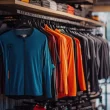The Best Customer Retention Tools in Retail

In today’s fiercely competitive sports retail industry, customer retention has become essential for maximizing profitability. With a vast array of choices and ever-evolving consumer behavior, sports retailers must stand out and create lasting relationships with their customers. This is where customer retention tools come into play, offering retailers a powerful method to boost revenue and drive long-term growth.
How can customer retention tools help you maximize profitability? What strategies should you implement online and offline? And which technological tools should you leverage? We provide all the answers in this article.
1. Customer Retention Tools: What Are the Benefits?
The Virtuous Circle of Customer Satisfaction
Customer retention tools enhance consumer engagement, encouraging them to shop more frequently and spend more. A loyal customer is a satisfied one who values the store and its products. As a result, they are more likely to:
- Shop more often: Exclusive benefits and targeted promotions prompt loyal customers to visit the store or its e-commerce platform more regularly.
- Spend more: By leveraging a customer’s purchase history, you can offer personalized and relevant deals, increasing their average spend.
The Power of Word-of-Mouth
In today’s digital landscape, positive word-of-mouth is a powerful marketing tool for sports retailers. A satisfied, loyal customer is far more likely to recommend your store to friends, family, and their online communities. These genuine recommendations significantly enhance brand visibility and appeal, attracting new customers and driving sales.
Long-Term Business Sustainability
Retaining existing customers is significantly more cost-effective than acquiring new ones, with acquisition costs often being 5 to 7 times higher. The statistics speak for themselves: increasing customer retention by just 5% can boost profits by 25% to 95%. Investing in customer retention tools secures long-term revenue for your sports retail business and supports steady, sustainable growth.
2. Customer Retention Strategies in Sports Retail
An Attractive, Industry-Specific Loyalty Program
A well-designed loyalty program is a fundamental step toward building long-term customer loyalty. To be effective, it needs to be appealing and tailored to the expectations of athletes. This means offering concrete and personalized benefits, such as discounts, exclusive offers, early access to product launches, or premium services.
Market leaders have grasped this concept well, with many examples of innovative loyalty programs. Nike stands out with its loyalty apps (Nike App, Nike Training Club, Nike SNKRS), providing customers with privileged access to product launches, personalized sports challenges, and exclusive content.
Go Sport, for instance, has introduced the “Mercure Program,” which allows customers to accumulate points from their purchases and convert them into vouchers, free products, or unique sports experiences.
Sport 2000 offers a “Sport Booklet” to help customers collect points with every purchase, which can be redeemed for future purchases. The Sport Booklet also offers exclusive perks like invitations to sports events or discounts on partner products.
Building a Community of Athletes
Creating a community around your store is a highly effective way to retain customers and establish lasting bonds with them. Don’t underestimate the social and human dimension of sports! Here are some tips to engage your customers:
- Sponsoring local sports events: Whether it’s running, cycling, or swimming, support local sports events to boost your brand’s visibility among athletes in your area.
- Organizing coaching or training sessions: Offer group classes led by professional coaches, tailored to the sports and skill levels of your target audience.
- Creating an outdoor team: Bring your customers together around a shared passion, encouraging group sports activities.
- Running an online forum or discussion group: Create a space for your customers to share tips, advice, and motivation with each other.
Offering High-Value Services
Preferential offers, vouchers, and loyalty points are effective, but they shouldn’t be the only focus. Offering a range of services that meet your customers’ needs is key to building loyalty and creating a satisfying customer experience. This can include:
- Equipment rentals to allow customers to try new sports or access high-end products more easily.
- Repair and maintenance services to extend the life of sports equipment and address environmental concerns.
- Product testing opportunities before purchase.
- Personalized advice from expert staff to help customers choose the right equipment for their needs.
Prioritizing Customer Relationships
The quality of your relationship with customers plays a crucial role in the overall experience and retention. It’s essential to address dissatisfaction with care and responsiveness to build trust. Don’t hesitate to regularly ask for customer feedback and personalize your communications.
Your goal should be to provide impeccable customer service across all touchpoints, including in-store, by phone, email, or social media, before, during, and after the purchase.

3. Technology to Support Customer Retention
Creating a Personalized Experience Through Data
The key to a successful retention strategy lies in having a deep understanding of your target audience. By collecting and analyzing customer data (purchases, history, preferences), sports retailers can create personalized and highly targeted shopping experiences.
This is where CRM (Customer Relationship Management) software comes into play. It helps you:
- Build detailed profiles of each customer: their shopping habits, favorite products, preferred communication channels, etc.
- Segment customers based on specific criteria (age, gender, location, interests).
- Implement personalized marketing actions: targeted offers, exclusive promotions, specialized newsletters.
- Anticipate customer needs and offer products or services that match their preferences through various communication channels (SMS, email, notifications).
Offering a Seamless Omnichannel Experience
Today’s consumers move effortlessly between digital and physical channels. To meet these new behaviors, sports retailers must offer a smooth, integrated online-to-offline experience. This means ensuring a consistent customer experience across all communication channels (website, mobile app, physical store) and enabling customers to start a purchase on one channel and complete it on another (click-and-collect, in-store pick-up for online orders, etc.). A unified loyalty program accessible across all platforms is also essential.
To manage these strategies effectively, adopting the right technological tools is critical. Management solutions are excellent allies for streamlining the customer experience and centralizing control across all channels. They offer a suite of complementary tools such as e-commerce management, marketing automation, and digital loyalty card functionality.
Digitalizing the In-Store Experience
A concrete example speaks louder than words. Adapting to new digital habits, Decathlon has implemented innovative technologies such as RFID to speed up the checkout process, and the Borne Plus to assist customers in-store while providing a digital experience. These tools allow the brand to offer a unique omnichannel experience, ultimately driving customer loyalty.
Additionally, Decathlon has equipped its stores with tablets in fitting rooms to facilitate communication between staff and customers, as well as virtual reality tools to showcase products in their real-life context.
Leveraging Technology for Superior Customer Service
A high-quality customer relationship requires innovative tools to improve service efficiency and personalization. Technology offers a wealth of options, including:
- Chatbots to answer customer inquiries in real-time.
- 24/7 accessible online FAQs.
- Contact forms to gather customer feedback and suggestions.
- Automated satisfaction surveys to measure customer satisfaction and identify areas for improvement.
- Complaint management tools to effectively address customer dissatisfaction.
Customer retention is essential for the success of sports retailers in an increasingly competitive and constantly evolving market. Technological tools, especially management software equipped with advanced modules, provide retailers with a powerful way to differentiate themselves.
However, beyond functionality, the chosen software must be flexible enough to keep up with market trends and innovations. It should also integrate seamlessly with other digital tools such as e-commerce platforms, marketing automation solutions, and customer review management systems. By choosing a scalable business tool, you ensure you have a long-term ally to support your growth and success.





